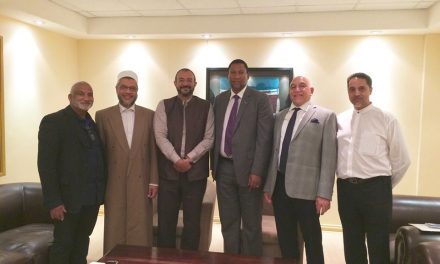Could Today’s UK be a ‘Land of Islam’?
What is the ‘Land of Islam’?
For: Contextualising Islam in Britain Project (CIBP),
Symposium Four, Cambridge University, April 25th and 26th, 2009

Introduction
One of the main concepts that shape Muslim minorities’ worldview and lifestyle is the concept of ‘Muslim countries’, or in other expressions, the ‘Islamic World’ or the ‘Land of Islam’. This concept has a great impact on the ‘contextualisation’ of Muslims in the west in general and in the UK in specific.
First, because some Muslims perceive that they live in a ‘non-Muslim’ or ‘disbelieving’ country, they give themselves a special status of an exceptional case, in which they allow themselves to abuse the system, break the law, or think that the principles of justice and honesty do not apply in their dealings in this country.
Some other Muslims, including some who are British in the roots and to the core, always yearn to live in the ‘Land of Islam’ or ‘Muslim countries’. They sometimes venture to immigrate or ‘move back’, only to face the shocking reality of many Muslim, and especially Arab, countries.
Moreover, and quite unfortunately, a few but loud groups of Muslims take the view that because they do not live in the ‘Land of Islam’, therefore they live in the ‘Land of War’. Bad politics and wars, also quite unfortunately, give these groups additional justifications to commit crimes – in the name of Islam – against their fellow citizens, and thus, add fuel to an already vicious and endless cycle.
Last but not least, a feeling that a Muslim does not live in his or her ‘natural’ and ‘default’ Land of Islam goes against their other feeling of belonging and identification with the country they already live in – the UK in our case. This conflict has serious implications on many issues, from politics to education to community participation and citizenship.
This article is asking two questions:
- What is the criteria for judging a certain geographical area to be a ‘Land of Islam’, in the Islamic traditional/classic sense?
- Based on these criteria, how can we assess a certain country (the UK as an example here) to being close to a ‘Land of Islam’?
Classic Definitions
I carried out a survey on the concept of the ‘Land of Islam’ (dar al-islam) in a large number of classic and contemporary sources of the Islamic law known to us today, which includes various Sunni, Shia, and Ibadi Schools of Law. The results of the survey reveal some interesting facts and popular misconceptions.
First of all, the two current popular criteria that define whether or not a country is ‘Islamic’ or part of the ‘Land of Islam’ are not supported by any school of Islamic law!
The first criteria is ‘having a 50% +1 majority of Muslims’, regardless of whether the constitution states that it is a ‘secular country’, such as Turkey and Malaysia, whether the head of state is non-Muslim, such as Lebanon, or whether the Islamic rituals and acts of worship are not generally practiced, such as a number of former Soviet Union States. In fact, classic judicial sources clearly state that the issue of Muslims being a majority or a minority in a certain country is irrelevant to a land being a ‘Land of Islam’, and some other criteria are suggested instead.[1]
The other popular criteria, which was recently applied to a rural region of tribal Pakistan in an attempt to get it out of the ‘Land of War’ zone (!), is the application of the ‘Islamic’ criminal law (or hudud). However, I also did not find any explicit mention in any school of law that relates the ‘Islamicity of a state’ or the concept of the ‘Land of Islam’ specifically to the hudud.
The question now is: What are the classic criteria for a ‘Land of Islam’?
The results of the survey could be summarised in the following five criteria.
- A land where Islamic rules (ahkam al-islam) apply.[2]
- A land where a Muslim ruler has control (isteela’) over its affairs.[3]
- A land of security (al-amn).[4]
- A land where the practicing of public acts of worship (sha`a’ir al-islam) is allowed.[5]
- A ‘Land of Justice’ (dar al-`adl).[6]
The following is a brief analysis of each of these concepts and their implications.
The ‘Land of Islamic Rulings’
A popular definition of the Land of Islam in classic sources is, ‘the land where the Islamic rulings apply’.[7] The question is: What are these ‘Islamic rulings’?
I have detailed elsewhere[8] that a statute could be labelled ‘Islamic’ if it has two conditions:
- The legal philosophy and purpose is to achieve the purpose and higher objectives of the Islamic Law (maqasid al-shari`ah) such as justice, freedom of choice, orderliness, and the preservation of faith/religion, soul/life, lineage/family, mind/intellect, dignity/honour, and wealth/ property.[9]
- Statutes shall not go against any fixed Islamic ruling. Defining what is ‘fixed’ and what is ‘variable’ is a complex question that I also attempted to answer elsewhere.[10]
But in any case, given that the concept of law, in the qanun (legal statutes) sense, was not known in the Muslim-majority countries until late nineteenth century,[11] it is safe to assume that the ‘application of the Shariah in the legal system’, or ‘Shariah-compliant laws’, were definitely not part of the ‘Land of Islam’ classic interpretation. These concepts have a ‘post-colonial’ context, the analysis of which is beyond the scope of this article.
Thus, the ‘Islamic ruling’ (ahkam al-islam) were explained in several other senses, which the rest of this article will attempt to explain.
The ‘Land of a Muslim Ruler’
To have a Muslim ruler in ‘control’ (isteela’) over the affairs of a certain land is a criterion that some classic and contemporary scholars used for judging that a certain land is indeed a ‘Land of Islam’.[12] Al-Mawardi, for example, explicitly mentions that ‘when Muslims reside in and control a certain land, it becomes a Land of Islam’.[13]
However, this criterion is subject to a number of conditions to be valid, prime of which is the ability of Muslims to practice their religious obligations, a public feeling of security, and the application of justice. A Muslim ruler who fails to observe or work towards these obligations jeopardises the status of ‘Land of Islam’ of his jurisdiction. Sheikh Rashid Reda summarizes related opinions as follows:
Indeed, many countries that are governed by Muslim leaders are countries where one is forced against practicing his/her religion and cannot reveal everything he/she believes in or fulfils his/her practical Islamic obligations, especially enjoying good, forbidden evil, and the ability to criticise rulings that go against the Law. This land, according to some scholars, is a ‘Land of War’.
Thus, the existence of enough security and freedom to allow Muslims to practice religion is, juridically speaking, more essential than the religion of the ruler.
The ‘Land of Security’
In fact, a number of Imams stated that security is the purpose (maqsud) of the Land of Islam versus Land of War classification, to start with, and not ‘Islam’ versus ‘non-Islam’ per se.
For example, Imam Abu Hanifa states:
The purpose (maqsud) of calling a certain land a ‘Land of Islam’ or a ‘land of disbelief (kufr)’ is not Islam versus kufr. It is security versus insecurity.[14]
Mecca itself – according to Imam al-Bayhaqi for example – became a ‘Land of Islam’ after its ‘conquest’ only because of its newly found sense of security. He writes:
Mecca became a ‘Land of Islam’ and ‘land of security’ after its conquest because no one there was forced against his/her religion. Any other land is likewise if it acquires the same kind of security.[15]
It is clear from the classic definitions too that security itself is means to the end of freedom to practice the Islamic ‘public acts of worship’ (Arabic: sha`a’ir al-islam). Several scholars mentioned that a Muslims who have enough security and freedom to practice sha`a’ir al-islam actually live in a ‘Land of Islam’, even if they were minority. Al-Qummi Al-Naisaburi explains:
Muslims, even a minority, are prevailing over non-Muslims, even if they were a majority, if they are not prevented from practicing the public Islamic acts of worship (sha`a’ir al-islam).[16]
The next section elaborates on the Islamic public acts of worship, which appear to form a more basic criterion for judging a land to be a ‘Land of Islam’.
The ‘Land of Freedom to practice Islam’
The majority of scholars and schools of Islamic law find this criterion to be the ‘true sign’ for a land to be a ‘Land of Islam’. Many of them refer to prophetic traditions that are interpreted to mean just that, such as related prophetic sayings about the importance of certain identifying acts, such as group prayers in the mosque, the call for prayer (azan), pilgrimage, the celebration of Eid, and so on. Al-Mawardi writes:
The public acts of worship (sha`a’ir) of Islam such as group prayers in mosques and call for prayers are the criteria by which the Prophet, peace be upon him, differentiated between the Land of Islam and the Land of Disbelief. [17]
Al-Razi writes:
If the Islamic acts of worship are evident in streets and public places, this certainly entails that Islam is dominant.[18]
Ibn Taymiyah writes:
The public acts of worship (sh`a’ir) of Islam are the true signs that a certain land is a Land of Islam.[19]
The ‘public acts of worship’ are defined to include a variety of Islamic rituals, such as the five prayers,[20] fasting in Ramadan,[21] giving zakah charity,[22] pilgrimage,[23] ablution,[24] Eid prayers,[25] reading the Quran,[26] sacrificing animals to feed the poor,[27] building mosques,[28] greeting people with ‘peace be upon you’,[29] and charitable endowments (awaqaf).[30]
But if we – objectively – assess various countries around the world based on Muslims’ freedom to practice the above specific Islamic acts of worship, and create some sort of ‘index’ for them, we will quickly realise that many European countries – including the UK – would score perhaps much higher than many Muslim-majority countries in that index.
The ‘Land of Justice’
This criterion, the achievement of justice, is so central in the Islamic in the Islamic concept of ‘Land of Islam’ to the extent that the ‘land of justice’ term interchangeably with the ‘Land of Islam’ term in numerous sources. [31]
Justice is the basis of all of the above criteria, according to Islamic jurists, and hence more fundamental in the Islamic principles and purposes. Thus, an ‘Islamic leadership’ that is not based on justice and is based on ‘ethnic solidarity’ (‘asabiyyah) does not constitute a valid condition for the ‘Land of Islam’. Rashid Reda, for example, writes:
The land of justice, which is the Land of Islam, is a land that has a true leader who establishes justice. This is contrary to the ‘land of injustice and aggression’, in which governorship is based on some Muslims’ ‘ethnic solidarity’ (`asabiyyah), regardless of the establishment of the Islamic rulings.[32]
Al-Mawardi also stresses the importance of ‘competence’ and a ‘good character’ of the leader in the ‘Land of Justice’. He writes:
People who are qualified to make decisions in the Land of Justice should choose a leader who possesses a good character and competent.[33]
Ibn Taymiyah holds the ‘achievement of justice’ in a state as most fundamental and deserving of God’s support, even for a ‘nation of disbelievers’. He writes:
In this life, people’s situations uphold when justice prevails in their society even if they fall into various kinds of sins. However, people’s situations do not uphold when injustice and lack of rights prevail in their society. That is why the saying goes: God upholds a state established on justice, even if it were a nation of disbelievers, and would not uphold a state established on injustice, even if it were a nation of Muslims. The other saying goes: This world lives with justice and disbelief, and does not live with injustice and Islam. The Prophet, peace be upon him, had said: ‘No sin has a faster Divine punishment than the sin of injustice …’. Thus, people of injustice fail in this life, even if they were to be forgiven in the hereafter. This is because justice is the universal law of things.[34]
Discussion
The ‘Land of Islam’ versus the ‘Land of War/Disbelief’, ‘good ruler’ versus ‘evil ruler’, ‘security’ versus ‘insecurity’, ‘freedom in practicing Islam’ versus ‘no freedom in practicing Islam’, and ‘justice’ versus ‘injustice’, are all false dichotomies!
All of the above black-and-white classifications of the world are almost never true, and a more realistic and ‘logical’ classification looks at not only the gray levels in between the black and white extremes, but various colours as well. In other words, the achievement of all the above criteria especially the three most fundamental, namely, security, freedom of practicing religion, and justice is relative, whether in Muslim-majority or Muslim-minority societies.
Thus, and regardless of popular opinions, the country that is juridically worthy of being a ‘Land of Islam’, ‘Land of Security’, or ‘Land of Justice’ is the country that achieves a relatively high score on the criteria that are detailed above.
The above judgement obviously requires a comprehensive and realistic survey of various countries in order to create a ‘ranking’ of some sort. However, being in the context of UK, a rough but very reasonable assessment of how the UK meets all of the above criteria gives it a relatively high score on the ‘Land of Islam’ scale!
[1] For example: Al-Qummi Al-Naisaburi, Nizamuddin (d. 728 h). Tafsir Ghara’ib al-Qur’an, Dar al-Kutub al-Ilmiyyah, Beirut, 1996, vol.3, p.459, and Al-Bayhaqi, Ahmad Ibn Al-Hussein (d. 458 h). Sunan al-Bayhaqi al-Kubra, Dar al-Bazz, Mecca, 1994, vol.9, p.16.
[2] For example: Ibn Al-Qayyim, Shamsuddin (d. 751 h). Ahkam Ahl al-Dhimmah, Ramady/Ibn Hazm, Beirut, 1997, vol.2, p.728, Reda, Rashid. Fatawa, Compiled by: Salahuddin Al-Munajjid and Yusuf Khouri, Dar al-Kitab-al-Jadeed, Beirut, 1390 h, Al-Qummi Al-Naisaburi, Tafsir Ghara’ib al-Qur’an, vol.3, p.459, Al-Sarakhsi, Shamsuddin (d. 483 h). Dar Al-Marifa, Beirut, without date, vol.9, p. 182, and Al-Yunini, Qutbuddin (d. 726 h). Dhail Mir’at al-Zaman, Al-Turath, Amman, without date, vol.2, p.58.
[3] For example: Al-Mawardi, Ali Ibn Mohammad (d. 450 h) Al-Hawi al-Kabeer fi Fiqh Madhab al-Imam al-Shafie, Dar al-Kutub, Beirut, 1999, vol.14, p.267, Reda, Fatawa, Reda, Rashid. Al-Khilafah, Al-Zahraa, Cairo, without date, p.50, Al-Mawardi, Ali Ibn Mohammad (d. 450 h). Al-Ahkam al-Sultaniyah wal-Wilayat al-Diniyah, Dar al-Kutub al-Ilmiyah, Beirut, 1985, vol..1, p.22, Al-Mawsili, Abdullah (d. 683 h). Al-Ikhtiyan, Dar al-Kutub Al-Ilmiyah, Beirut, 2005, vol.4, p.178, and Al-Qummi Al-Naisaburi, vol.3, p.459.
[4] For example: Al-Bayhaqi, vol.9, p.16, Al-Kasani, Alauddin(d. 587 h). Bada’i` al-Sana’i` fi Tartib al-Shara’i`, Dar al-Kitab al-`Arabi, Beirut, 1982, vol.7, p.131, Al-Sarakhsi, vol.9, p. 182.
[5] For example: Ibn Taymiyah, Ahmad (d. 728 h). Al-Nubuwat, Al-Matba`ah Al-Salafiyah, Cairo, 1386 h, vol.1, p.197, Al-Razi, Mohammad Ibn Omar (d. 606 h). Al-Mahsul, Jamiat Al-Imam, Riyad, 1400 h, vol.4. p.43, Al-Mawardi, Ali Ibn Mohammad (d. 450 h). Al-Ahkam al-Sultaniyah wal-Wilayat al-Diniyah, Dar al-Kutub al-Ilmiyah, Beirut, 1985, vol..1, p.275, Al-Nasa’i, Ahmad, (d. 303 h). Al-Jum`ah, Al-Turath, Amman, without date, p.10, Al-Kalabadhi Al-Bukhari, Abu-Bakr (d. 384 h). Bahr al-Fawa’id, Dar Al-Kutub Al-Ilmiyah, Beirut, 1999, vol.1, p.130, Al-Mawardi, Ali Ibn Mohammad (d. 450 h) Al-Hawi al-Kabeer fi Fiqh Madhab al-Imam al-Shafie, Dar al-Kutub, Beirut, 1999, vol.2, p.48, Ibn Al-Arabi, Abu BAkr (d 543 h). Ahkam al-Quran, Dar al-Fikr, Lebanon, vol.1, p.368, Ibn Al-Arabi, Abu BAkr (d 543 h). Ahkam al-Quran, Dar al-Fikr, Lebanon, vol.1, p.530, Al-Kasani, Alauddin(d. 587 h). Bada’i` al-Sana’i` fi Tartib al-Shara’i`, Dar al-Kitab al-`Arabi, Beirut, 1982, vol.7, p.113, Al-Razi, Mohammad Ibn Omar (d. 604 h). Al-Tafsir Al-Kabeer, Dar Al-Kutub Al-Ilmiyah, Beirut, vol.32, p.108, Al-Mawsili, Abdullah (d. 683 h). Al-Ikhtiyan, Dar al-Kutub Al-Ilmiyah, Beirut, 2005, vol.4, p.178, Al-Yunini, Qutbuddin (d. 726 h). Dhail Mir’at al-Zaman, Al-Turath, Amman, without date, vol.2, p.58, Ibn Taymiyah, Ahmad (d. 728 h). Kutub wa Rasa’il wa Fatawa, Maktabat Ibn Taymiyah, without date, vol.23, p.146, and Ibn Taymiyah, Kutub wa Rasa’il wa Fatawa, Maktabat Ibn Taymiyah, vol.28, p.408.
[6] For example: Ibn Taymiyah, Ahmad (d. 728 h). Kutub wa Rasa’il wa Fatawa, Maktabat Ibn Taymiyah, without date, vol.28, p.146, Reda, Al-Khilafah, p.50, 62, Al-Mawardi, Al-Ahkam al-Sultaniyah, vol.1, p.22, Al-Sarakhsi, Shamsuddin (d. 483 h). Al-Usul, Dar Al-Marifa, Beirut, without date, vol.9, p. 182, Al-Kasani, Alauddin(d. 587 h). Bada’i` al-Sana’i` fi Tartib al-Shara’i`, Dar al-Kitab al-`Arabi, Beirut, 1982, vol.7, p.80, Ibn Qudamah, Abdullah Al-Maqdisi (d. 620 h). Al-Mughni fi Fiqh al-Imam Ahmad, Dar Al-Fikr, Beirut, 1405 h, vol.9, p.14, Al-Nawawi, Muhammad (d. 676 h). Rawdat al-Talibin wa `Umdat al-Muftim, Al-Maktab Al-Islami, Beirut, 1405 h, vol.10, p.49, Al-Zar`i, Mohmmad Ibn Abu Bakr (d. 751h). Al-Jawab al-Kafi Liman Sa`al `an al-Dawa’ al-Shafi, Dar al-Kutub Al-Ilmiyah, Beirut, 1405 h, vol.1, p.101, Ibn Abidin, Mohammad (d. 1252 h). Hashiyat Raddul-Mukhtar, Dar al-Fikr, Beirut, 2000, vol.4, p.45, Al-Alusi, Shihabuddin (d 1270 h). Ruh al-Ma`ani fi Tafsir al-Quran al-`Adheem, Dar Ihyaa al-Turath al-`Arabi, Beirut, without date, vol.18, p.91, Nizam, al-Sheikh. Al-Fatawa al-Hindiyah, Dar al-Fikr, 1991, vol.2, p.179, Reda, Rashid. Al-Khilafah, Al-Zahraa, Cairo, without date, p.50.
[7] For example: ref 1, 4, 5, 12, 32. Ibn Al-Qayyim, Ahkam Ahl al-Dhimmah, vol.2, p.728, Reda, Fatawa, Al-Qummi Al-Naisaburi, vol.3, p.459, Al-Sarakhsi, vol.9, p. 182, and Al-Yunini, Dhail Mir’at al-Zaman, vol.2, p.58.
[8] J. Auda, ‘What is a ‘Shariah-compliant’ law?’, The Islamic law and its Application Seminar, Doha Legal Forum, May 29-31, 2009, Qatar.
[9] J. Auda, Maqasid al-Shariah as Philosophy of Islamic Law: A Systems Approach, International Institute of Islamic Thought (IIIT), London, 2008.
[10] J. Auda, Fiqh al-Maqasid, International Institute of Islamic Thought (IIIT), Virginia, 2006.
[11] Rashid Reda, ‘Mujmal Al-Ahwal Al-Siyasiyah,’ al-˒Urwah al-Wuthqa, Feb. 29th, 1898 CE.
[12] For example: Al-Mawardi, Al-Hawi al-Kabeer, vol.14, p.267, Reda, Fatawa, Al-Qummi Al-Naisaburi, vol.3, p.459, and Al-Bayhaqi, Sunan al-Bayhaqi, vol.9, p.16.
[13] Al-Mawardi, Al-Hawi al-Kabeer, vol.14, p.267.
[14] Al-Kasani, Bada’i` al-Sana’i`, vol.7, p.131.
[15] Al-Bayhaqi, Sunan al-Bayhaqi, vol.9, p.16.
[16] Al-Qummi Al-Naisaburi, Tafsir Ghara’ib al-Qur’an, vol.3, p.459.
[17] Al-Mawardi, Al-Ahkam al-Sultaniyah, vol.1, p.275.
[18] Al-Razi, Al-Mahsul, vol.4, p.43.
[19] Ibn Taymiyah, Al-Nubuwat, vol.1, p.197.
[20] Al-Mawardi, Al-Ahkam al-Sultaniyah, vol.1, p.275, Ibn Al-Arabi, Ahkam al-Quran, vol.1, p.368, 530, Al-Razi, Al-Tafsir, vol.32, p.108, and Ibn Taymiyah, Kutub wa Rasa’il, vol.28, p.408.
[21] Ibn Al-Arabi, Ahkam al-Quran, vol.1, p.530.
[22] Al-Razi, Al-Tafsir, vol.32, p.108.
[23] Al-Kalabadhi Al-Bukhari, Bahr al-Fawa’id, vol.1, p.130.
[24] Ibid.
[25] Al-Mawardi, Al-Hawi al-Kabeer, vol.2, p.48.
[26] Ibn Al-Arabi, Ahkam al-Quran, vol.1, p.368, and Ibn Taymiyah, Kutub wa Rasa’il, vol.28, p.408.
[27] Ibid., vol.23, p.146.
[28] Ibid., vol.28, p.408, and Al-Yunini, Dhail Mir’at al-Zaman, vol.2, p.58.
[29] Al-Kasani, Bada’i` al-Sana’i`, vol.7, p.113.
[30] Al-Yunini, Dhail Mir’at al-Zaman, vol.2, p.58.
[31] For example: Ibn Taymiyah, Kutub wa Rasa’il, vol.28, p.146, Reda, Al-Khilafah, p.50, 62, Al-Mawardi, Al-Ahkam al-Sultaniyah, vol.1, p.22, Al-Sarakhsi, al-Usul, vol.9, p. 182, Al-Kasani, Bada’i` al-Sana’i`, vol.7, p.80, Ibn Qudamah, Al-Mughni, vol.9, p.14, Al-Nawawi, Rawdat al-Talibin, vol.10, p.49, Al-Zar`i, Al-Jawab al-Kafi, vol.1, p.101, Ibn Abidin, Hashiyat Raddul-Mukhtar, vol.4, p.45, Al-Alusi, Ruh al-Ma`ani, vol.18, p.91, Nizam, Al-Fatawa al-Hindiyah, vol.2, p.179, and Reda, Al-Khilafah, p.50.
[32] Reda, Ibid.
[33] Al-Mawardi, Ibid.
[34] Ibn Taymiyah, Ibid.






